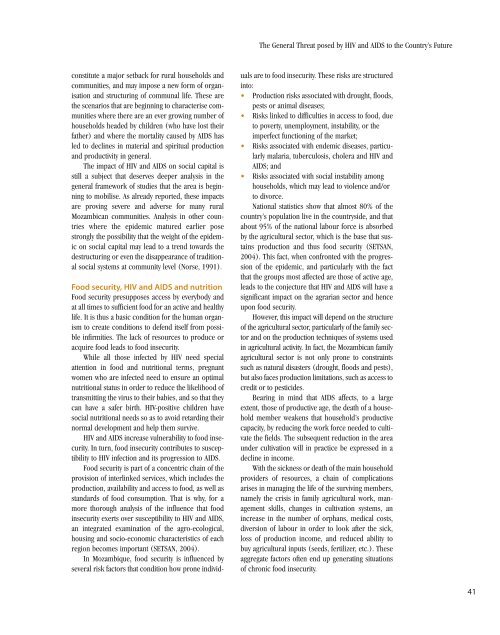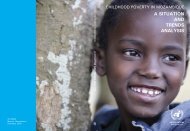English language version - Human Development Reports - United ...
English language version - Human Development Reports - United ...
English language version - Human Development Reports - United ...
- No tags were found...
You also want an ePaper? Increase the reach of your titles
YUMPU automatically turns print PDFs into web optimized ePapers that Google loves.
The General Threat posed by HIV and AIDS to the Country’s Futureconstitute a major setback for rural households andcommunities, and may impose a new form of organisationand structuring of communal life. These arethe scenarios that are beginning to characterise communitieswhere there are an ever growing number ofhouseholds headed by children (who have lost theirfather) and where the mortality caused by AIDS hasled to declines in material and spiritual productionand productivity in general.The impact of HIV and AIDS on social capital isstill a subject that deserves deeper analysis in thegeneral framework of studies that the area is beginningto mobilise. As already reported, these impactsare proving severe and adverse for many ruralMozambican communities. Analysis in other countrieswhere the epidemic matured earlier posestrongly the possibility that the weight of the epidemicon social capital may lead to a trend towards thedestructuring or even the disappearance of traditionalsocial systems at community level (Norse, 1991).Food security, HIV and AIDS and nutritionFood security presupposes access by everybody andat all times to sufficient food for an active and healthylife. It is thus a basic condition for the human organismto create conditions to defend itself from possibleinfirmities. The lack of resources to produce oracquire food leads to food insecurity.While all those infected by HIV need specialattention in food and nutritional terms, pregnantwomen who are infected need to ensure an optimalnutritional status in order to reduce the likelihood oftransmitting the virus to their babies, and so that theycan have a safer birth. HIV-positive children havesocial nutritional needs so as to avoid retarding theirnormal development and help them survive.HIV and AIDS increase vulnerability to food insecurity.In turn, food insecurity contributes to susceptibilityto HIV infection and its progression to AIDS.Food security is part of a concentric chain of theprovision of interlinked services, which includes theproduction, availability and access to food, as well asstandards of food consumption. That is why, for amore thorough analysis of the influence that foodinsecurity exerts over susceptibility to HIV and AIDS,an integrated examination of the agro-ecological,housing and socio-economic characteristics of eachregion becomes important (SETSAN, 2004).In Mozambique, food security is influenced byseveral risk factors that condition how prone individ-uals are to food insecurity. These risks are structuredinto:• Production risks associated with drought, floods,pests or animal diseases;• Risks linked to difficulties in access to food, dueto poverty, unemployment, instability, or theimperfect functioning of the market;• Risks associated with endemic diseases, particularlymalaria, tuberculosis, cholera and HIV andAIDS; and• Risks associated with social instability amonghouseholds, which may lead to violence and/orto divorce.National statistics show that almost 80% of thecountry’s population live in the countryside, and thatabout 95% of the national labour force is absorbedby the agricultural sector, which is the base that sustainsproduction and thus food security (SETSAN,2004). This fact, when confronted with the progressionof the epidemic, and particularly with the factthat the groups most affected are those of active age,leads to the conjecture that HIV and AIDS will have asignificant impact on the agrarian sector and henceupon food security.However, this impact will depend on the structureof the agricultural sector, particularly of the family sectorand on the production techniques of systems usedin agricultural activity. In fact, the Mozambican familyagricultural sector is not only prone to constraintssuch as natural disasters (drought, floods and pests),but also faces production limitations, such as access tocredit or to pesticides.Bearing in mind that AIDS affects, to a largeextent, those of productive age, the death of a householdmember weakens that household’s productivecapacity, by reducing the work force needed to cultivatethe fields. The subsequent reduction in the areaunder cultivation will in practice be expressed in adecline in income.With the sickness or death of the main householdproviders of resources, a chain of complicationsarises in managing the life of the surviving members,namely the crisis in family agricultural work, managementskills, changes in cultivation systems, anincrease in the number of orphans, medical costs,di<strong>version</strong> of labour in order to look after the sick,loss of production income, and reduced ability tobuy agricultural inputs (seeds, fertilizer, etc.). Theseaggregate factors often end up generating situationsof chronic food insecurity.41
















